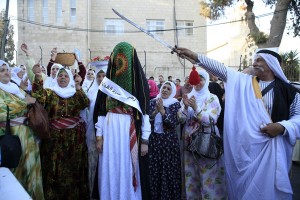Brightly clad brides at the center of the occasion
[Ramallah] – For the third year running, a colorful parade showcasing traditional Palestinian bridal dresses livened up the streets of the town of Birzeit. The “Flower of the Countryside” competition, organized by the non-governmental organization Rozana and local partners, aims to revive Palestinian heritage and culture in the form of the pre-1948 “zaffa,” or wedding march.
Eleven villages from throughout the West Bank took part in the 2015 competition to present the special features of their local wedding traditions: costumes, songs, dance and lululish. Girls from 14 to 18 years of age were selected to showcase the wedding dress representative of their region.
Groups of women adorned in richly ornamented gowns and men wearing the qumbaz and the sword, surrounding the bride, marched while singing and dancing from the Al-Natour Square to the garden of the Catholic church where a stage was set up for the competition. Five judges noted the quality and the originality of each bride’s dress. Also, each bride had to draw the traditional henna on the hands of their girlfriends and share homemade cakes from the feast.
“The festival seeks to revive the pride among villagers about their culture and to transfer it from one generation to another. We believe that it is important in times of uncertainty under occupation to raise hope among the people by bringing their national identity, and by praising this identity and making them feel united together,” Terry Bullata, a volunteer coordinator from Jerusalem, told The Media Line.
The bridal dress is the centerpiece of the ceremony. Traditionally, it was completely handmade, requiring hours of work to weave, embroider and to add embellishments to the handcrafted garments. Wedding dresses could be made from scratch or, as some girls prefer, be the dress worn by their mother or grandmother after adding a few alterations and a little tailoring.
The creation of these dresses played a significant role in the lives of the women, the patterns displaying heritage, ancestry, and affiliations. Historically, the garment was one of the features that indicated regional identity and local social standing, as explained by the local proverb saying, “A Palestinian woman’s village can be deduced from the embroidery on her dress.”
A wide range of textiles was used to design traditional costumes and dresses: Damascus velvets; muslin and tabby silk from Iraq; fine white cotton from Lebanon; linen from Egypt; and silk from China. Great emphasis was placed on ornamentation with valuable coins sewn into the headdress.
Ornamental embroidery was specific to the areas of Ramallah, Bethlehem and Hebron. In the north of the West Bank, traditionally populated by peasantry, the time consuming practice is less common because women had to attend to their fields. It is for that reason that wedding dresses from the north emphasize bright colors and accessories such as belts and headscarves rather than elaborate ornamentation seen in the three main cities.
Dressmaking skills were systematically passed from grandmother to granddaughter as the young girl reached the age of seven or eight. But today, Palestinians living in the cities have adopted a Western style and abandoned traditional costumes with many modern brides choosing to marry in a pure white dress instead.
“Traditions are not being lost, but rather are being modified and modernized. We cannot expect things to stay the same, but we need to remember what has been before,” Dr. Sonya Nimer, teacher of Oral History and Traditions at Birzeit University, told The Media Line. “Even if we don’t expect our youth to wear these costumes, we want them to know the culture of their ancestors. We need to associate the past with the present,” Nimer said.
Although the centricity of wedding costumes is being largely abandoned, other traditions remain alive in the wedding ceremony. The Henna party, held on the night before the wedding, is one of the most important rituals. Previously practiced by both the bride and the groom, nowadays, mostly the bridal henna party has survived. Although, the ritual has lost its initial meaning of marking the bride and instead has now become a beauty ritual.
“Recently, we notice that young brides are reviving the culture, and taking out of the closets the dresses of their grandmother that they proudly wear on their wedding night,” concluded Dr. Nimer.
